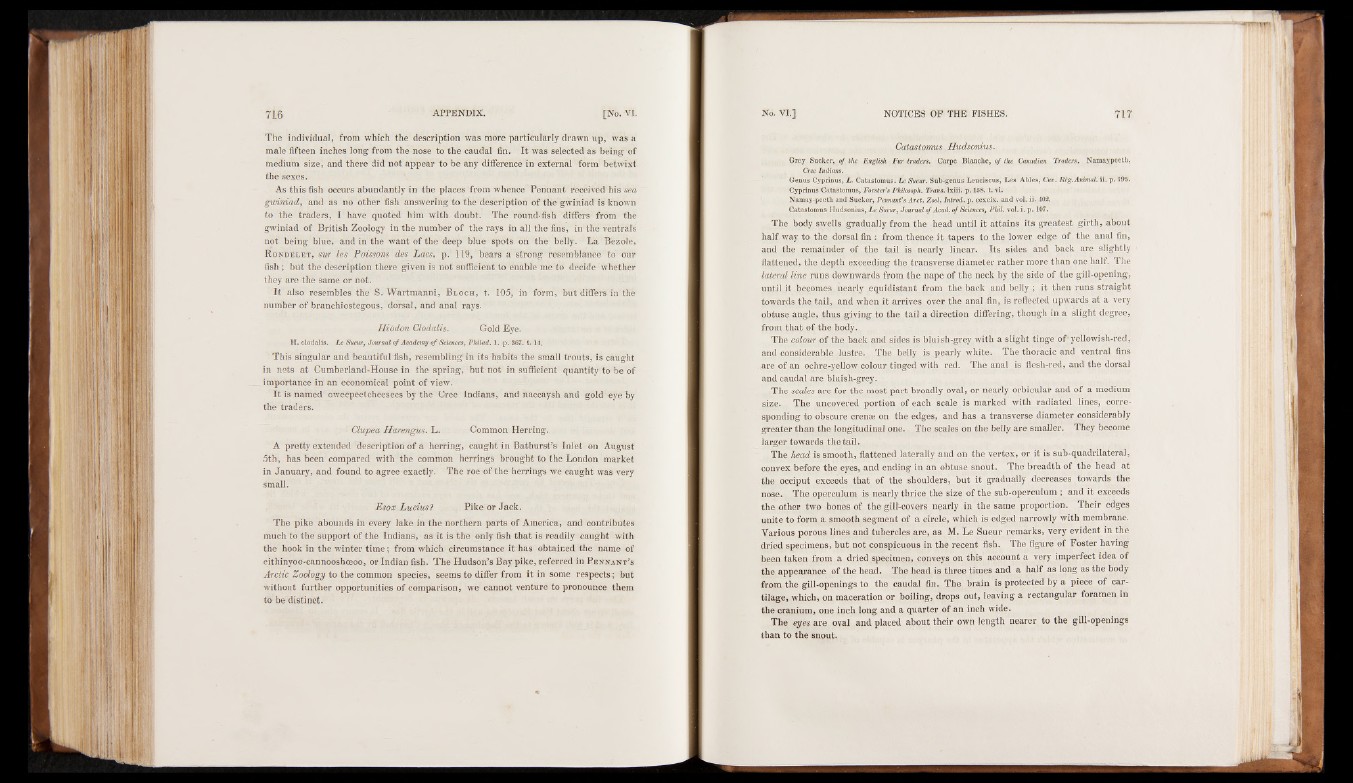
The individual, from which the description was more particularly drawn up, was a
male fifteen inches long from the nose to the caudal fin. It was selected as being of
medium size, and there did not appear to be any difference in external form betwixt
the sexes.
As this fish occurs abundantly in the places from whence Pennant received his sea
gwiniad, and as no other fish answering to the description of the gwiniad is known
to the traders, I have quoted him with doubt. The round-fish differs from the
gwiniad of British Zoology in the number of the rays in all the fins, in the ventrals
not being blue, and in the want of the deep blue spots on the belly. La Bëzole,
R o n d e l e t , sur les Poissons des Lacs, p. 119, bears a strong resemblance to our
fish ; but the description there given is not sufficient to enable me to decide whether
they are the same or not.
It also resembles the S. Wartmanni, B l o c h , t. 105, in form, but differs in the
number of branchiostegous, dorsal, and anal rays.
Hiódon Clodalis. Gold Eye.
H. clodalis. L e Sueur, Journal o f Academy o f Sciences, Philad. 1. p. 367. 1.14.
This singular and beautiful fish, resembling'in its habits the small trouts, is caught
in nets at Cumberland-House in the spring, but not in sufficient quantity to be of
importance in an economical point of view.
It is named oweepeetcheesees by the Cree Indians, and naccaysh and gold eye by
the traders.
1 Clupea Harengus. L. Common Herring..
A pretty extended description of a herring, caught in Bathurst’s Inlet on August
5th, has been compared with the common herrings brought to the London market
in January, and found to agree exactly. The roe of the herrings we caught was very
small.
Esox Lucius? Pike or Jack.
The pike abounds in every lake in the northern parts of America, and contributes
much to the support of the Indians, as it is the only fish that is readily caught with
the hook in the winter time; from which circumstance it has obtained the name of
eithinyoo-cannooshceoo, or Indian fish. The Hudson’s Bay pike, referred in P e n n a n t ’s
Arctic Zoology to the common species, seems to differ from it in some respects ; but
without further opportunities of comparison, we cannot venture to pronounce them
to be distinct.
Catastomus Hudsonius.
Grey Sucker, of the English Fur traders. Carpe Blanche, o f the Canadian Traders. Namaypeeth,
Cree Indians.
Genus Cyprinus, L . Catastomus. Le Sueur. Sub-genus Leuciscus, Les Abies, Cuv. R ig.A nim al. ii. p. 195.
Cyprinus Catastomus, Forster’s Philosoph. Trans, lxiii. p. 158. t. vi.
Namay-pecth and Sucker, Pennant’s Arct. Zool. lntrod. p. ccxcix. and vol. ii. 402.
Catastomus Hudsonius, Le Sueur, Journal o f Acad, o f Sciences, P hil. vol. i. p. 107.
The body swells gradually from the head until it attains its greatest girth, about
half way to the dorsal fin : from thence it tapers to the lower edge of the anal fin,
and the remainder of the tail is nearly linear. Its sides and back are slightly
flattened, the depth exceeding the transverse diameter rather more than one half. The
lateral line runs downwards from the nape of the neck by the side of the gill-opening,
until it becomes nearly equidistant from the back and belly ; it then runs straight
towards the tail, and when it arrives over the anal fin, is reflected upwards at a very
obtuse angle, thus giving to the tail a direction differing, though in a slight degree,
from that of the body.
The colour of the back and sides is bluish-grey with a slight tinge of* yellowish-red,
and considerable lustre. The belly is pearly white. The thoracic and ventral fins
are of an ochre-yellow colour tinged with red. The anal is flesh-red, and the dorsal
and caudal are bluish-grey.
The scales are for the most part broadly oval, or nearly orbicular and of a medium
size. The uncovered portion of each scale is marked with radiated lines, corresponding
to obscure crense on the edges, and has a transverse diameter considerably
greater than the longitudinal one. The scales on the belly are smaller. They become
larger towards the tail.
The head is smooth, flattened laterally and oh the vertex, or it is sub-quadrilateral,
convex before the eyes, and ending in an obtuse snout. The breadth of the head at
the occiput exceeds that of the shoulders, but it gradually .decreases towards the
nose. The operculum is nearly thrice the size of the sub-operculum ; and it exceeds
the other two bones of the gill-covers nearly in the same proportion. Their edges
unite to form a smooth segment of a circle, which is edged narrowly with membrane.
Various porous lines and tubercles are, as M. Le Sueur remarks, very evident in the
dried specimens, but not conspicuous in the recent fish. The figure of Foster having
been taken from a dried specimen, conveys on this account a very imperfect idea of
the appearance of the head. The head is three times and a half as long as the body
from the gill-openings to the caudal fin. The brain is protected by a piece of cartilage,
which, on maceration or boiling, drops out, leaving a rectangular foramen in
the cranium, one inch long and a quarter of an inch wide.
The eyes are oval and placed about their own length nearer to the gill-openings
than to the snout.